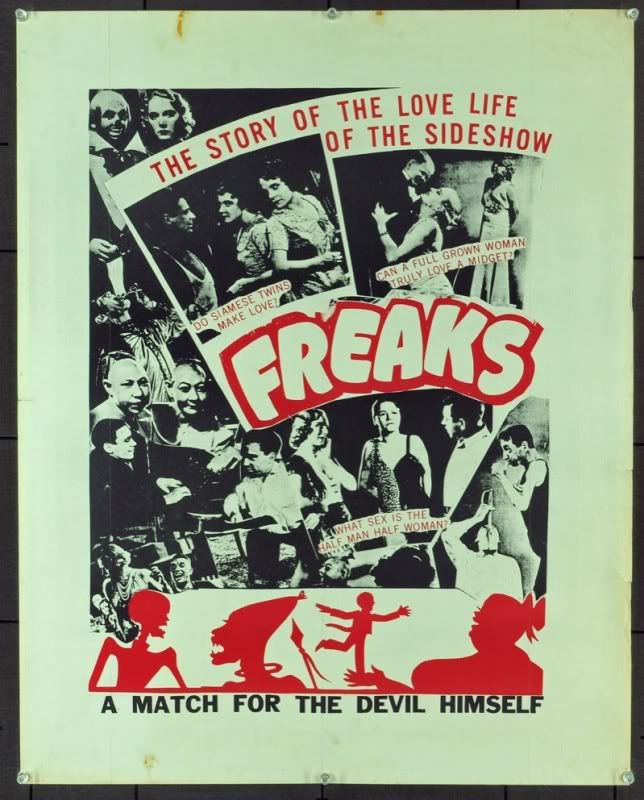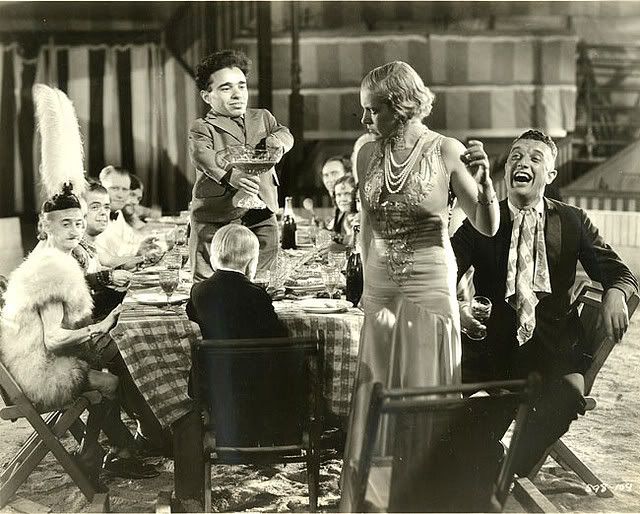 |
| Fig.1 Freaks Poster. |
Freaks is a horror film, but not in the conventional sense. Its main focus is on the day to day lives of the performers in a freak show and not their actual performances. These performers are absolutely incredible because they are all real-life members from a freak show. This is absolutely fascinating for the viewers as it is completely unexpected, but it also caused a lot of trouble for the director. The display of these 'freaks' was considered a great worry, as Joan Hawkins explained that "Confusion about the film seems to have stemmed largely from the use of real freaks to play the parts. 9 Critics worried that the film merely replicated the most unsavoury aspects of the “Freak Show.”" (Hawkins, 2000:142) This is perhaps the main concern for a film covering this kind of subject matter. Freak shows are a completely barbaric and unpleasant business that profit from taking advantage of the vulnerable and unfortunate sufferers of deformity. Any film that would include such an 'unsavoury' topic might also be doing it to earn money from the audience's disgust at those unnatural 'freaks', but this is not at all what the film is trying to do.
This is particularly clear when the performers' comradery is juxtaposed by the selfish and vain trapeze artist. She's beautiful and 'normal'. She has no physical deformity but her absence of compassion and sincerity is far more monstrous and inhuman than anything these performers could have. This is where the real horror of the film lies, not in the 'unnatural' deformities of the performers but in much more malevolent realities of human nature. Ina Rae Hark expressed that "The status of what defines an abnormal monster, the role of violence in society, and the place of community codes of conduct, all timely themes, were also in play in the year’s most reviled film, Freaks." (Hark, 2007:76) This shows support towards the idea that the definition of an 'abnormal monster' is challenged in this film. It is no longer the traditional deformed monster that seeks to tarnish everything that is good and pure, but is replaced by the far too ordinary reality of human selfishness and greed. The mention of 'community codes of conduct' also plays a part in the horror of this film. The last section features the performers act of punishment on the trapeze artist and her partner for being deliberately horrid and abusive towards the 'freaks' as she called them. Sadly, most of the sequence is lost because it was deemed too terrible to be shown, but the aftermath at the end is quite terrifying. Another shame is that the performers had to stoop to the level of becoming things of horror in order to do this, but the viewers are still undoubtedly on their side.
Figure 1. Freaks poster. At: http://movieart.net/wp-content/uploads/2011/05/full.freaks-vert-23x29-16444%20.jpg
Figure . Table: At: http://farm1.staticflickr.com/44/146686936_c0c26a8e0e_z.jpg?zz=1
Bibliography
Hark, Ina Rae. (2007) American Cinema of the 1930s : Themes and Variations. USA: Rutgers University Press.
Hawkins, Joan. (2000) Cutting Edge : Art-Horror and the Horrific Avant-Garde. USA: University of Minnesota Press.
Odell, Colin; Le Blanc, Michelle (2001) Horror Films. GBR: Pocket Essentials.



:D
ReplyDelete